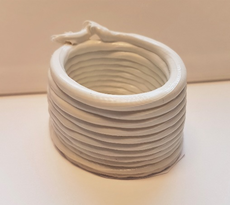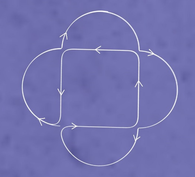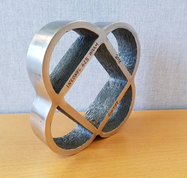This video summarizes the findings of his thesis: Navigating emerging technologies and knowledge demands: system perspectives on knowledge development in Norwegian manufacturing industry.
|
Henrik Brynthe Lund is a Research Scientist working at SINTEF Digital's Department of Technology Management. Henrik was previously a PhD candidate at SFI Manufacturing. He can be reached at [email protected]. This video summarizes the findings of his thesis: Navigating emerging technologies and knowledge demands: system perspectives on knowledge development in Norwegian manufacturing industry. Welding robots are the "cousins" of 3D printers and can create machine parts on-site, when they are needed.
You can read the full text in Norwegian, published in Gemini and Dagens Næringsliv. This article was written by:
 Tina Bergh has submitted the following academic thesis as part of the doctoral work at the Norwegian University of Science and Technology (NTNU): Electron microscopy of intermetallic phases in aluminium-steel joints Tina has been part of Research Area 1 - Multi-Material Products and Processes. She will hold a trial lecture May 28 at 10:15, and the public defence of the thesis will begin at 13:15. The lecture and defence are open for digital participation at: https://s.ntnu.no/Trial_lecture_Tina_Bergh and https://s.ntnu.no/PhD_defence_Tina_Bergh. Assessment CommitteeThe Faculty of Natural Sciences has appointed the following Assessment Committee to assess the thesis:
SupervisorsThe doctoral work has been carried out at the Department of Physics, where Associate Professor Per Erik Vullum has been the candidate’s supervisor. Professor Randi Holmestad, Department of Physics, NTNU and Associate Professor Ida Westermann, Department of Materials Science, NTNU have been the candidate’s co-supervisors.
On April 6, 2021, Amalie Østhassel will start as a new PhD student at SFI Manufacturing. She has recently been working as a trainee in the European Free Trade Association (EFTA). Her PhD is being undertaken on behalf of NTNU. We welcome Amalie and look forward to the collaboration! About Amalie
Mathias Hauan Arbo was one of the first PhD candidates of SFI Manufacturing. In april 2019 he finished his thesis on "Robotic assembly and optimization-based control of industrial manipulators". We asked him to tell us a bit more about his research. – My thesis has two main topics: An idealized automatic assembly system, capable of generating and executing robot programs based on CAD models, and closed-loop inverse kinematics systems for on-line control of an industrial manipulator, explains Mathias. The thesis is a collection of papers related to these topics written during Mathias’ work at SFI Manufacturing. The accompanying text in the thesis gives a brief introduction to the history of robotics, as well as an overview of some of the robotics literature. Mathias started his SFI Manufacturing Postdoc Spring 2019. During his Postdoc he will be working on high-level planning and control of articulated robots for assembly, exploiting expert knowledge and CAD information. Read Mathias his thesis here Find the presentation of the defendence (and video) here An independent report shows that SFI Manufacturing potentially can have an economic impact of >3 billion NOK per year in the Norwegian manufacturing industry. SFI Manufacturing is a cross-disciplinary centre for research-based innovation for competitive high value manufacturing in Norway. The centre is hosted by SINTEF Manufacturing AS, it has 14 industry partners, and SINTEF and NTNU as research partner. An analysis of the independent advisory firm Impello Management AS shows that the centre potentially can have an economic impact of >3 billion NOK per year in the Norwegian manufacturing industry. SFI Manufacturing has been awarded 30 IPN projects in the period of 2016-2019. The analysis of Impello Management AS is based on 15 of these projects started in 2018, and statements of the industry partners in relation to these projects. To realize the potential economic impact, significant investments from the industry will be required. More potential impact The analysis shows more potential economic impacts in addition to the 3 billion NOK as well: Reduced operating costs, increased profits and reduced investments. These impacts are based on 8 use cases linked to the 15 IPN projects. The use cases are subsequently linked to one or more of the centre's research areas: Multi-material products and processes, Flexible and robust automation, and Sustainable and innovative organizations. Specifically, the 8 use cases are covering the fields of:
It is in these fields where the potential economic impact of SFI Manufacturing lies. Key facts about SFI Manufacturing
Contact person
Automated production line at Plasto AS, a leading company in the injection molding industry, and one of the industry partners of SFI Manufacturing. Photo: Plasto AS
Three new PhD students started at SFI Manufacturing recently! We would like to welcome all three students, Chaman, Ingrid and Andreas, and invite you to read a bit more about their studies. Chaman is linked to research area 1, Multi-Material Products and Processes, and will be looking at the lifetime prediction of composites. Ingrid is linked to research area 2, Robust and Flexible Automation, and will be working on flexible and automated robotized deburring. Andreas is also linked to research area 2 and will be working on robotized additive manufacturing. Below, they will tell you a bit more about their studies. Would you like to follow Chaman, Ingrid and Andreas and the results of their studies? Keep an eye on this blog :) Chaman Srivastava – Lifetime prediction of composites
Ingrid Fjordheim Onstein – Flexible and automated robotized deburring
Andreas Hanssen Moltumyr – Robotized additive manufacturing
Flott artikkel i Gemini om hjemhenting av produksjon, med kommentar av Henrik Brynthe Lund, som er som stipendiat knyttet til SFI Manufacturing, og forsker på hva vareproduserende bedrifter i Norge gjør for å holde seg konkurransedyktige.
– Fortsatt er den globale trenden at vareproduksjon flyttes fra høykostland til lavkostland. Men vi har fått en del eksempler på hjemflytting, eller reshoring, som det kalles. Det begynner å bre seg en bevissthet blant norske bedriftsledere at det faktisk er mulig, sier Henrik. I sin studie har Henrik tatt for seg ni bedrifter som har flyttet hjem produksjonen fra lavkostland i Øst-Europa og Østen. For flere av dem er automatisering og robotisering nøkkelen til hjemhenting. Da får man produsere med færre arbeidere, og spare inn på produksjonskostnadene. Les mer i artikkelen her Linn Danielsen Evjemo is one of the PhD-candidates of SFI Manufacturing. In this blog, she takes us along on a journey about additive manufacturing using industrial robots. My name is Linn Danielsen Evjemo, and I started my PhD work in December 2016. My project is focused on large-scale, robotized additive manufacturing (AM) using industrial robot arms, with a special focus on cold metal transfer welding (CMT). The aim is to combine the large workspace of an industrial robot arm with the flexibility and relative affordability of traditional AM methods. Early in my PhD I did some preliminary experiments together with PostDoc Signe Moe (also part of SFI Manufacturing), building a simple cup-structure in a viscous glue using a UR-5 robot manipulator, as shown in figure 1A. The cup structure, shown in figure 1B, was built from the bottom-up in a continuous helix-path, which separates this from traditional AM methods that require the build to be done strictly layer-by-layer. Figure 1A and 1B: Images from proof-of-concept experiment using robot manipulator and an air-pressure driven caulking gun. The focus has later been on building metal structures using arc-welding, mostly CMT. These experiments have been done in collaboration with technician Morten Høgseth Danielsen, and later also PhD fellow Geir Langelandsvik, at SINTEF Industry. In the first experiments, a simple box structure was built in a semi-layer-wise manner using aluminum, in order to map the basic challenges related to temperature and material behavior for a continuous build. Figure 2A and 2B: 2A shows a simulation of the path used to build the aluminum box structure shown in 2B, which has dimensions 12 x 12 cm2. The layer height in the simulation in 2A is not representative of the actual welding process. We have later focused on challenges related to intersections within each layer, as well as keeping a build going (close to) continuously. This has been tested both with aluminum and with a nickel alloy (Inconel 625), the latter shown in figure 3B and 3C. As can be expected, it was easier to keep the shape of the structure under control when using a metal with a higher melting point, because this made the structure less likely to distort as the build went along and the temperature rose. Figure 3A, 3B and 3C: Here we can see the path for the weld in order to avoid actual crossings within each layer, and the final metal structure before and after processing. The dimensions are approximately 16 x 16 cm2.
The next step will be to advance to more complex structures, and to try and exploit the freedom in orientation of the robot arm to build structures that could not be built using traditional AM methods. Eirik Bådsvik Hamre Korsen is one of the PhD-candidates of SFI Manufacturing. In this blog, he introduces us to the world of performance management systems in manufacturing organizations.
I am Eirik, a PhD-student funded by SFI Manufacturing at NTNU, and working at NTNU at Gjøvik. I have been a management consultant within the field of performance management and system implementation before exploring academia. At SFI Manufacturing, I am a part of research area three, innovative and sustainable organizations. In my PhD, I study performance management systems in manufacturing organizations. Performance management tools An interesting observation is how organizations are useing different performance management tools in parallel, which all have the same purpose: to implement the organizational strategy. Most organizations have a management reporting system based on a set of key performance indicators, often inspired by, or based on, balanced scorecards. In parallel, they have a quality management system, which is audited and qualified for certification. In additional, they are useing a number of operational or lean tools and techniques. In my PhD, I explore how the organization uses these different tools and techniques, in the light of strategic alignment, the dilemma of difference perspectives between engineers versus business management educated managers, and how this is being influenced by digitalization and IT-systems. I question to what extent these tools contribute to the strategic alignment of the organization. Are any of these tools in conflict with each other or counterproductive? At to what extent are they integrated into each other, or are they living parallel lives? Digitalization After Kaplan and Johnsen (1987) “Relevance lost”, there has been a debate on how management accounting can be relevant and reflect the organization's operations. One of their explanations is the different educational background of business management and finance versus engineers. To what extent does this dilemma still exists? The performance management tools are often tightly linked to the organization's IT-systems. A buzz word these days is digitalization, and many ask how this will impact their organizations. I ask how digitalization will influence the performance management systems, and how we manage our organization? Processes, tools and techniques As manufacturing (or any organization) continually needs to improve to survive, I hope to contribute on how we can improve the performance management processes, tools and techniques used in organizations. I believe, by using the right tools to the right purpose in an efficient and effective manner, we can increase the basis for decision making, allocation or priority of resources, and motivation of employees and managers. |
Categories
All
Archives
May 2023
|


















 RSS Feed
RSS Feed
